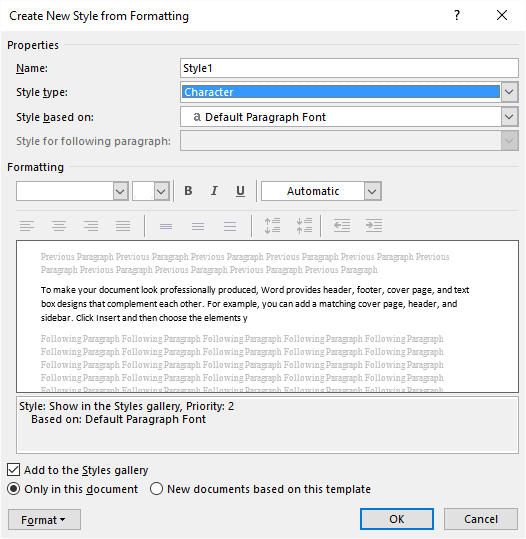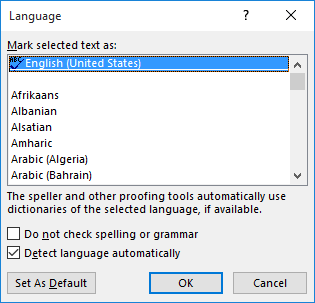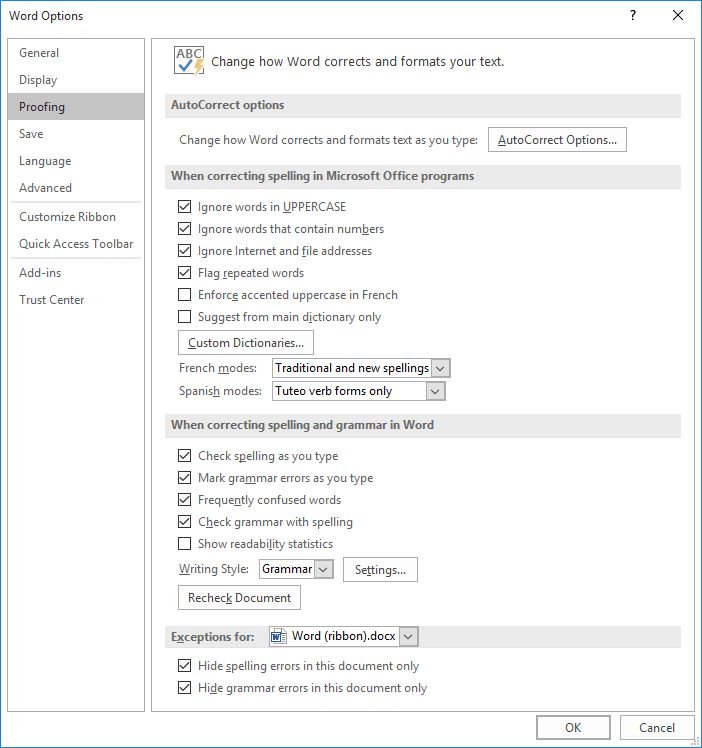Check The Document For Writing Errors
Forcing Word to Display Spelling and Grammar Errors
![]()
Chrys constantly works on huge multilingual documents. When he opens a document, he often sees a warning that there are "Too Many Spelling or Grammatical Errors to Continue Displaying Them." This is a bother; he doesn't want to do a manual spelling check (which the warning says he can do). Chrys wants to somehow instruct Word that he wants it to display all the errors, even if there are many of them.
Part of the reason why there are so many spelling errors in your document is because Word is assuming that your prose is all in English when, in fact, you are using multiple languages. You can reduce the number of spelling errors if you format your text to use the languages appropriate to that text. In other words, format your German text as German, your French text as French, and so on. If you do this, then Word knows which spelling dictionaries to use in doing its checking.
The easiest way to do this is to create character styles for each of your languages. For instance, let's say you wanted to create a character style to be used with your German text. You would follow these steps:
- Display the Home tab of the ribbon.
- Click the small icon at the lower-right corner of the Styles group. Word displays the Styles task pane.
- Click on the New Style button in the lower-left corner of the task pane. Word displays the Create New Style from Formatting dialog box. (See Figure 1.)
- In the Name box, type a name for your new style, such as GermanText.
- Using the Style Type pull-down list, select the Character option.
- Click the Format, then choose Language. Word displays the Language dialog box. (See Figure 2.)
- In the list of available languages, locate and select the German language you want to use. (There are several variations of German. The one you select should be one for which you have proofing tools available in your copy of Word.)
- Click OK to close the Language dialog box.
- Click on OK again. The new GermanText style has now been created.
- Close the Styles task pane.

Figure 1. The Create New Style from Formatting dialog box.

Figure 2. The Language dialog box.
You can repeat these steps for each of the languages you use in the document. Then, select the text you want to format and apply the appropriate character style for that language. Restart Word and open the document to see if you get the same error message.
If you still get the "too many errors" message, then other approaches will need to be taken. The message doesn't appear unless there are in excess of approximately 1,400 spelling errors in the document. This threshold is hardwired and cannot be changed. Even so, Word still does the background spelling check so that it knows how many spelling errors there are—it simply doesn't display them all "as you type" if the threshold is exceeded. Because it knows how many there are, you could use a macro to display the count, in case you are curious.
Sub HighlightSpellingErrors() Dim sMsg As String sMsg = "There are " & ActiveDocument.SpellingErrors.Count sMsg = sMsg & " spelling errors in the document." MsgBox sMsg End Sub
Unfortunately, once Word believes you've passed the 1,400-error threshold, it not only displays the error message, but it also turns off the display of spelling errors in the document. This is why, earlier, I mentioned restarting Word after applying the language-specific character styles in the document; restarting should allow the display of the spelling errors.
If you want to manually turn on the display of spelling errors, you can do so by following these steps:
- Display the Word Options dialog box. (In Word 2007 click the Office button and then click Word Options. In Word 2010 and later versions display the File tab of the ribbon and then click Options.)
- At the left side of the dialog box, click Proofing. (See Figure 3.)
- At the bottom of the dialog box, make sure the Hide Spelling Errors in This Document Only check box is cleared.
- Click on OK.

Figure 3. The proofing options of the Word Options dialog box.
Another approach is to turn off spell checking for certain parts of your document. To do this, you use the same steps described earlier in creating language-specific styles. You would create a character style that has the language set to "Do Not Check Spelling or Grammar" (step 7), and you then apply that character style to portions of the document you don't want checked. The idea, again, is to get the error count under the 1,400 threshold. (Remember to restart Word or follow the earlier steps to allow checking if you think you've reduced the error count enough.)
Finally, you could use a macro to highlight all the spelling errors in a document. This approach works regardless of the number of spelling errors, but it provides only a snapshot of the errors at the time the macro is run. This means that it is not dynamic; it will not update as you add new text or as you get rid of spelling errors.
Sub HighlightSpellingErrors() Dim r As Range ' Clear existing highlighting ActiveDocument.Range.HighlightColorIndex = wdNoHighlight ' Highlight spelling errors For Each r In ActiveDocument.SpellingErrors r.HighlightColorIndex = wdYellow Next r End Sub
After running the macro, any highlighting you previously applied in your document is gone and all spelling errors are highlighted in yellow.
If you would like to know how to use the macros described on this page (or on any other page on the WordTips sites), I've prepared a special page that includes helpful information. Click here to open that special page in a new browser tab.
WordTips is your source for cost-effective Microsoft Word training. (Microsoft Word is the most popular word processing software in the world.) This tip (13498) applies to Microsoft Word 2007, 2010, 2013, and 2016.
Author Bio
With more than 50 non-fiction books and numerous magazine articles to his credit, Allen Wyatt is an internationally recognized author. He is president of Sharon Parq Associates, a computer and publishing services company. Learn more about Allen...
MORE FROM ALLEN
Stopping Automatic Changes from Being Tracked
Track Changes is a great feature for keeping track of what gets changed in a document. There are some things (such as ...
Discover More
Selecting Tabs in Dialog Boxes
Dialog boxes normally present information in a series of tabs. If you want to move from tab to tab without taking your ...
Discover More
Wrapping Text Around a Graphic
Place a graphic in your document, and you may want to make sure that your document text "wraps" around the edges of the ...
Discover More
Check The Document For Writing Errors
Source: https://wordribbon.tips.net/T013498_Forcing_Word_to_Display_Spelling_and_Grammar_Errors.html
Posted by: duncanfachaps00.blogspot.com

0 Response to "Check The Document For Writing Errors"
Post a Comment